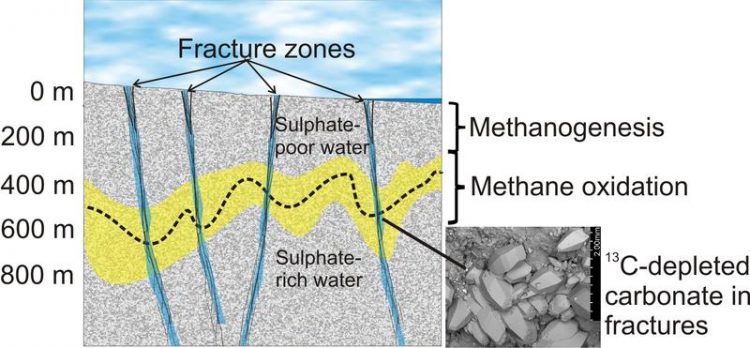Previously unknown sink for methane deep discovered deep in granitic rock

Schematic image of the preferential occurrence of methane oxidation at the transition to a deep sulphate-rich water.
The methane in the granite is consumed through microbe-mediated anaerobic oxidation, a process dominantly described from marine seabeds where it significantly mitigates the escape of methane to the atmosphere. However, the methane oxidation deep in the granite shows several intriguing differences compared to marine seabeds.
What makes the methane oxidation in the energy-poor fractured granite unique compared to other environments is the previously unseen magnitude of 13C-depletion in the carbonates precipitated during the methane oxidation.
The isotopic composition of co-genetic sulphide and specific biomarkers (e.g. fatty acids) preserved within the carbonates suggest presence of syntrophic consortia of methane oxidisers and sulphate-reducers.
Another unique feature in the fractured granite is that methane formed at shallow depth and oxidised at several hundred meters depth at the transition to a deep-seated sulphate-rich saline water.
This spatial distribution of methane and sulphate is completely opposite to what is observed during methane oxidation in near surface environments such as seabeds.
This previously unknown methane-trapping process of surficial methane at the transition to a deep sulphate-rich water can theoretically be widespread in the sparsely investigated deep terrestrial landscape. This process can thereby be of importance for the carbon cycling within the upper crust and for preventing methane to reach the atmosphere.
The results are presented in the article ”Extreme 13C-depletion of carbonates formed during oxidation of biogenic methane in fractured granite” in Nature Communications (open access).
Contact: Henrik Drake, henrik.drake@lnu.se
http://www.nature.com/ncomms/2015/150507/ncomms8020/abs/ncomms8020.html
Media Contact
All latest news from the category: Earth Sciences
Earth Sciences (also referred to as Geosciences), which deals with basic issues surrounding our planet, plays a vital role in the area of energy and raw materials supply.
Earth Sciences comprises subjects such as geology, geography, geological informatics, paleontology, mineralogy, petrography, crystallography, geophysics, geodesy, glaciology, cartography, photogrammetry, meteorology and seismology, early-warning systems, earthquake research and polar research.
Newest articles

Combining robotics and ChatGPT
TUM professor uses ChatGPT for choreographies with flying robots. Prof. Angela Schoellig has proved that large language models can be used safely in robotics. ChatGPT develops choreographies for up to…

How the Immune System Learns from Harmless Particles
Our lungs are bombarded by all manner of different particles every single day. Whilst some are perfectly safe for us, others—known as pathogens—have the potential to make us ill. The…

Biomarkers identified for successful treatment of bone marrow tumours
CAR T cell therapy has proven effective in treating various haematological cancers. However, not all patients respond equally well to treatment. In a recent clinical study, researchers from the University…





















